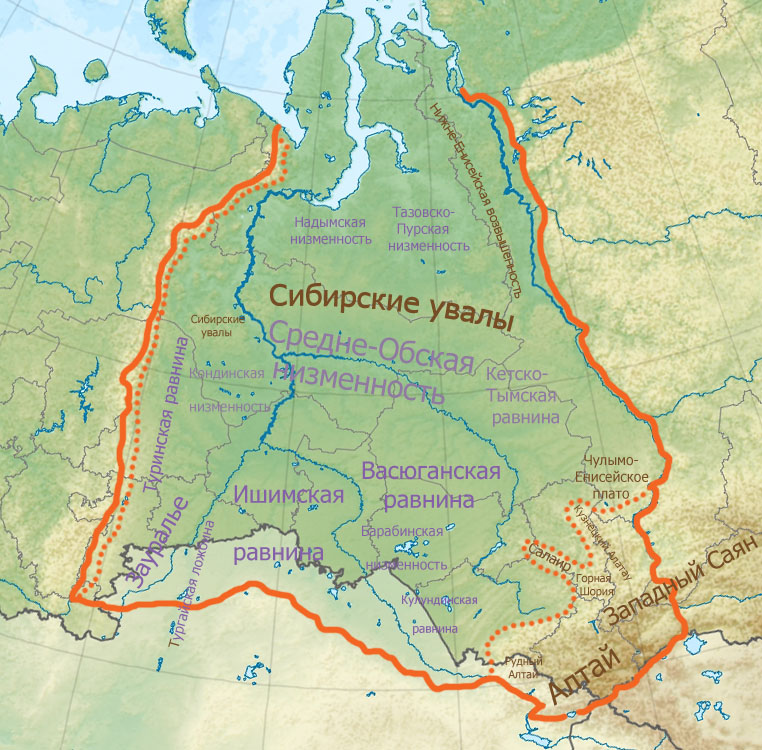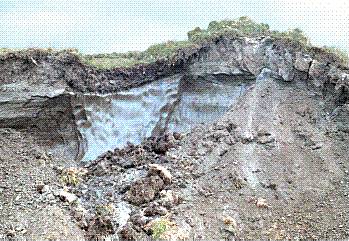|
Gas Emission Crater
A gas emission crater is recent arctic phenomenon where melting permafrost releases enormous volumes of trapped gas in an explosive event. The holes were first spotted in 2013. Meanwhile, the first known crater "Yamal crater" ( ru) in Yamal Peninsula was discovered in the summer of 2014; later, several dozen with more similar landforms were discovered. Soon it was proposed to call them in the scientific literature as "Gas emission craters". Known craters are located in the circumpolar regions of Western Siberia on land, on the bottom of rivers and lakes. The nature of the formation of these formations is still being studied, the reasons and mechanism of their formation are unclear, but most researchers agree in the opinion that their formation most likely occurs under the influence of fluid-dynamic processes in permafrost, which lead to the appearance of zones of accumulation of free natural gas near the surface. In this case, when the reservoir pressure of the accumulated gas fl ... [...More Info...] [...Related Items...] OR: [Wikipedia] [Google] [Baidu] |
Yamal Peninsula
The Yamal Peninsula (russian: полуостров Ямал, poluostrov Yamal) is located in the Yamalo-Nenets Autonomous Okrug of northwest Siberia, Russia. It extends roughly 700 km (435 mi) and is bordered principally by the Kara Sea, Baydaratskaya Bay on the west, and by the Gulf of Ob on the east. At the northern end of this peninsula lie the Malygina Strait and, beyond it, Bely Island. Across the river lies the Gyda Peninsula. In the language of its indigenous inhabitants, the Nenets, "Yamal" means "End of the Land". The Yamal peninsula is inhabited by a multitude of migratory bird species. The well-preserved remains of Lyuba, a 37,000-year-old mammoth calf, were found by a reindeer herder on the peninsula in the summer of 2007. The animal was female and was determined to be one month old at the time of death. Geography The peninsula consists mostly of permafrost ground and there are numerous lakes of thermokarst origin, the biggest of which are Neito ... [...More Info...] [...Related Items...] OR: [Wikipedia] [Google] [Baidu] |
Western Siberia
Western Siberia or West Siberia (russian: Западная Сибирь, Zapadnaya Sibir'; kk, Батыс Сібір) is a part of the larger region of Siberia that is mostly located in the Russian Federation. It lies between the Ural region and the Yenisei River, which conventionally divides Siberia into two halves. Western Siberia covers an area of , nearly 80% of which is located within the West Siberian Plain. The largest rivers of the region are the Irtysh and the Ob. The West Siberian petroleum basin is the largest hydrocarbon (petroleum and natural gas) basin in the world covering an area of about 2.2 million km2, and is also the largest oil and gas producing region in Russia. In medieval times, the region was part of the Golden Horde. After its gradual decline during the 15th century, the Khanate of Sibir, centered on Tyumen, was formed within the area. In the late 16th century, most of Western Siberia was conquered by the Russian Empire, while its southern region ... [...More Info...] [...Related Items...] OR: [Wikipedia] [Google] [Baidu] |
Cryovolcanism On The Earth
A cryovolcano (sometimes informally called an ice volcano) is a type of volcano that erupts volatiles such as water, ammonia or methane into an extremely cold environment that is at or below their freezing point. The process of formation is known as cryovolcanism. Collectively referred to as cryomagma, cryolava or ice-volcanic melt, these substances are usually liquids and can form plumes, but can also be in vapour form. After the eruption, cryomagma is expected to condense to a solid form when exposed to the very low surrounding temperature. Cryovolcanoes may potentially form on icy moons and other objects with abundant water past the Solar System's snow line (such as Pluto). A number of features have been identified as possible cryovolcanoes on Pluto, Titan and Ceres, and a subset of domes on Europa may have cryovolcanic origins. In addition, although they are not known to form volcanoes, ice geysers have been observed on Enceladus and potentially Triton. One potential ene ... [...More Info...] [...Related Items...] OR: [Wikipedia] [Google] [Baidu] |
Permafrost
Permafrost is ground that continuously remains below 0 °C (32 °F) for two or more years, located on land or under the ocean. Most common in the Northern Hemisphere, around 15% of the Northern Hemisphere or 11% of the global surface is underlain by permafrost, with the total area of around 18 million km2. This includes substantial areas of Alaska, Greenland, Canada and Siberia. It can also be located on mountaintops in the Southern Hemisphere and beneath ice-free areas in the Antarctic. Permafrost does not have to be the first layer that is on the ground. It can be from an inch to several miles deep under the Earth's surface. It frequently occurs in ground ice, but it can also be present in non-porous bedrock. Permafrost is formed from ice holding various types of soil, sand, and rock in combination. Permafrost contains large amounts of biomass and decomposed biomass that has been stored as methane and carbon dioxide, making tundra soil a carbon sink. As global ... [...More Info...] [...Related Items...] OR: [Wikipedia] [Google] [Baidu] |
Natural Gas
Natural gas (also called fossil gas or simply gas) is a naturally occurring mixture of gaseous hydrocarbons consisting primarily of methane in addition to various smaller amounts of other higher alkanes. Low levels of trace gases like carbon dioxide, nitrogen, hydrogen sulfide, and helium are also usually present. Natural gas is colorless and odorless, so odorizers such as mercaptan (which smells like sulfur or rotten eggs) are commonly added to natural gas supplies for safety so that leaks can be readily detected. Natural gas is a fossil fuel and non-renewable resource that is formed when layers of organic matter (primarily marine microorganisms) decompose under anaerobic conditions and are subjected to intense heat and pressure underground over millions of years. The energy that the decayed organisms originally obtained from the sun via photosynthesis is stored as chemical energy within the molecules of methane and other hydrocarbons. Natural gas can be burned for he ... [...More Info...] [...Related Items...] OR: [Wikipedia] [Google] [Baidu] |
Overburden Pressure
Pressure is force magnitude applied over an area. Overburden pressure is a geology term that denotes the pressure caused by the weight of the overlying layers of material at a specific depth under the earth's surface. Overburden pressure is also called lithostatic pressure, or vertical stress. In a stratigraphic layer that is in hydrostatic equilibrium; the overburden pressure at a depth z, assuming the magnitude of the gravity acceleration is approximately constant, is given by: P(z) = P_0 + g \int_^ \rho(z) \, dz Where: * z is the depth in meters. * P(z) is the overburden pressure at depth z. * P_0 is the pressure at the surface. * \rho(z) is the density of the material above the depth z. * g is the gravity acceleration in m/s^2 . In deep-earth geophysics/geodynamics, gravitational acceleration varies significantly over depth and g should not be assumed to be constant, and should be inside the integral. Some sections of stratigraphic layers can be sealed or isolated. T ... [...More Info...] [...Related Items...] OR: [Wikipedia] [Google] [Baidu] |
Cryovolcano
A cryovolcano (sometimes informally called an ice volcano) is a type of volcano that erupts volatiles such as water, ammonia or methane into an extremely cold environment that is at or below their freezing point. The process of formation is known as cryovolcanism. Collectively referred to as cryomagma, cryolava or ice-volcanic melt, these substances are usually liquids and can form plumes, but can also be in vapour form. After the eruption, cryomagma is expected to condense to a solid form when exposed to the very low surrounding temperature. Cryovolcanoes may potentially form on icy moons and other objects with abundant water past the Solar System's snow line (such as Pluto). A number of features have been identified as possible cryovolcanoes on Pluto, Titan and Ceres, and a subset of domes on Europa may have cryovolcanic origins. In addition, although they are not known to form volcanoes, ice geysers have been observed on Enceladus and potentially Triton. One potential e ... [...More Info...] [...Related Items...] OR: [Wikipedia] [Google] [Baidu] |
Arctic Methane Release
Arctic methane release is the release of methane from seas and soils in permafrost regions of the Arctic. While it is a long-term natural process, methane release is exacerbated by global warming. This results in a positive feedback cycle, as methane is itself a powerful greenhouse gas. The Arctic region is one of the many natural sources of the greenhouse gas methane. Global warming accelerates its release, due to both release of methane from existing stores, and from methanogenesis in rotting biomass. Large quantities of methane are stored in the Arctic in natural gas deposits, permafrost, and as undersea clathrates. Permafrost and clathrates degrade on warming, thus large releases of methane from these sources may arise as a result of global warming. Other sources of methane include submarine taliks, river transport, ice complex retreat, submarine permafrost and decaying gas hydrate deposits. Methane concentrations are 8–10% higher in the Arctic than in the Antarctic atm ... [...More Info...] [...Related Items...] OR: [Wikipedia] [Google] [Baidu] |




